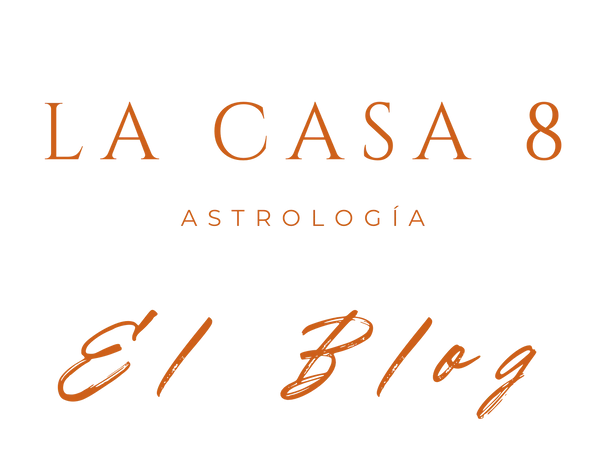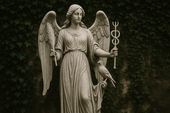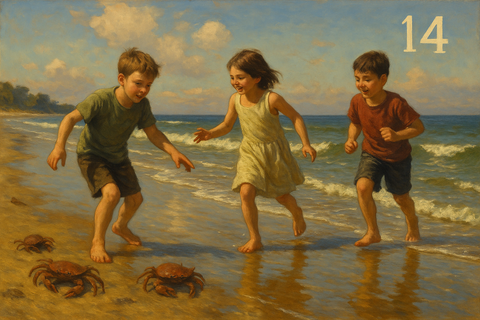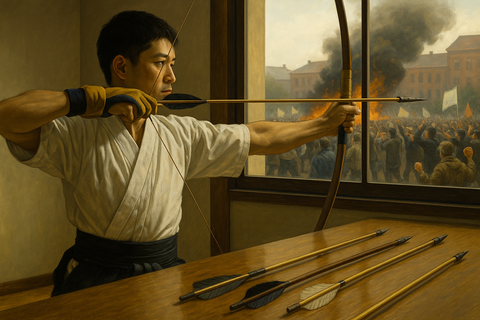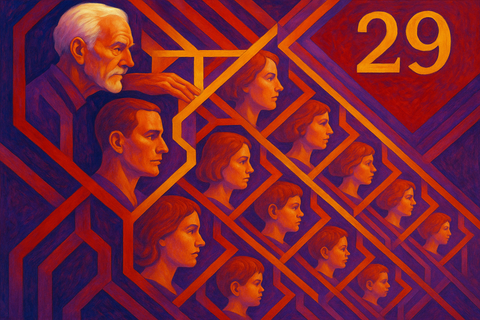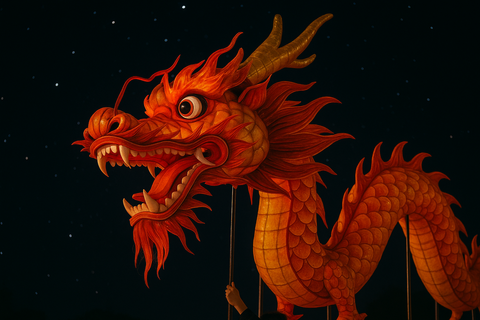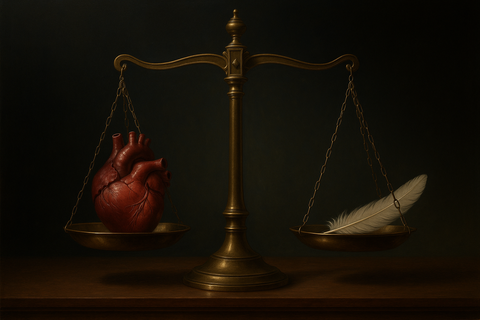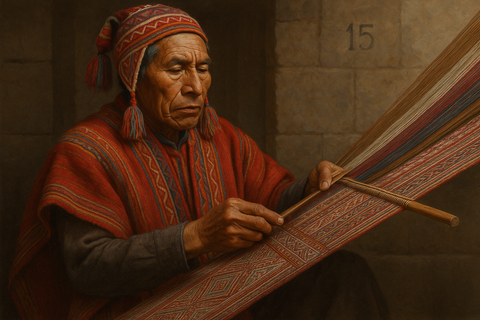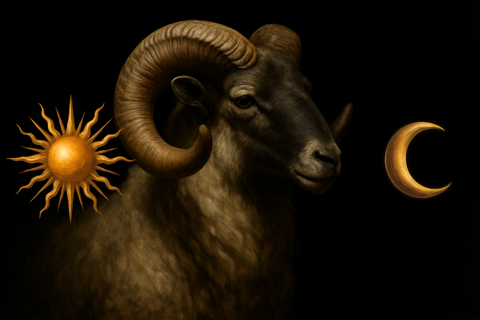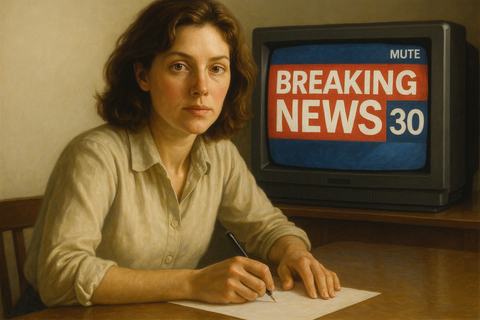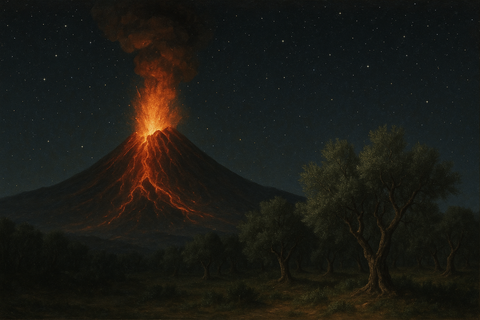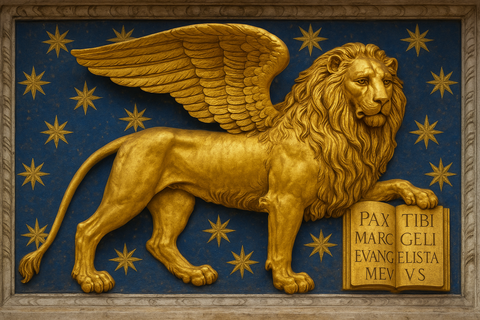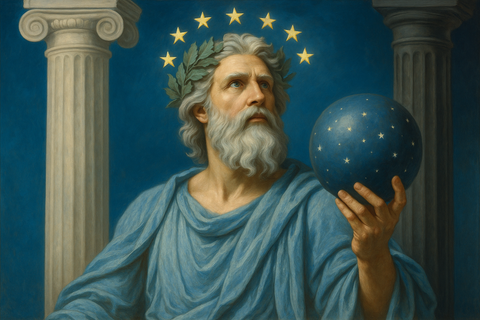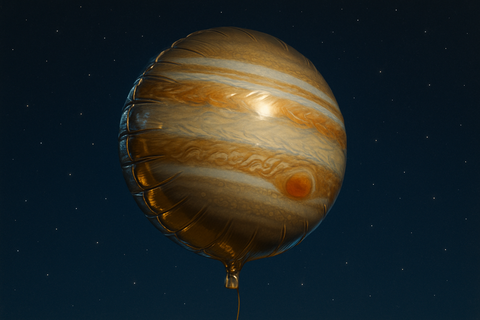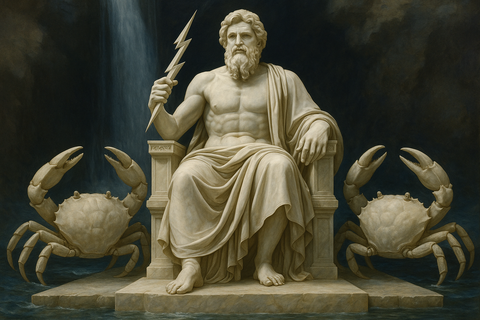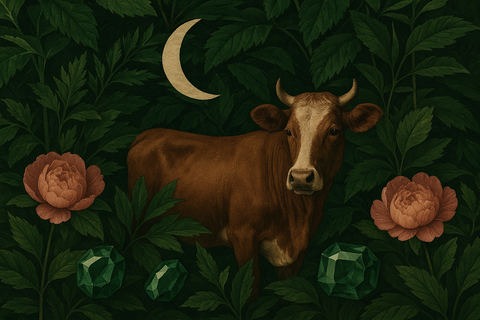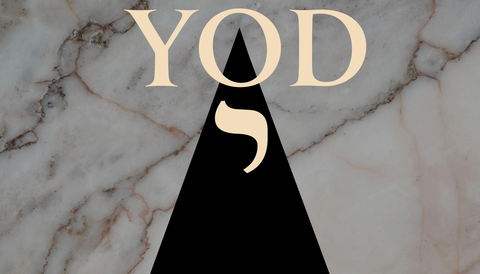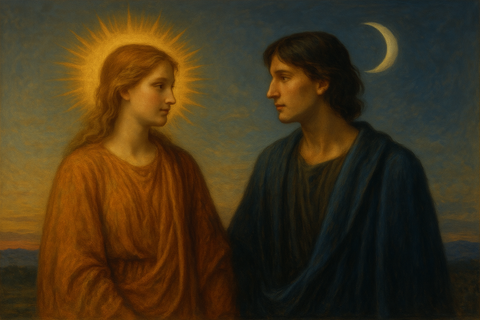This is the sixth part of a 12-part series exploring the energy of each zodiac sign. Today's post is dedicated to Virgo . Beyond the popular astrology that associates signs with personality, we'll delve into their most essential meanings: their archetypal nature, their symbols, their characteristics, and their manifestation in the human experience on both a personal and collective level.
What is a Zodiac Sign?
Before talking about Virgo itself, it's important to clarify the following: when we talk about signs, most people assume we're referring to the personality of those whose Sun is in that sign. This is actually a huge simplification that leaves out many layers of valuable meaning for us.
First of all, a zodiac sign is not a person or a personality type . It's a pattern of expression, a way a principle behaves . In astrology, principles are represented by planets, asteroids, angles, and any other points on the celestial sphere. Depending on the sign they fall under, their manifestation takes on a specific quality. And that quality is, in essence, an archetype.
What is an Archetype?
An archetype is an essential pattern, an image or energy that is repeated throughout history and in different cultures . They are primordial models that structure the way we experience reality. In astrology, each sign is an archetype with its own characteristics, an energetic quality that shapes the way any astrological principle is expressed.
When a planet is in a sign, the archetype of that sign acts through it . The sign doesn't change the essence of the planet, but it does determine its style of manifestation. For example, Saturn will behave very differently when it's in Taurus than when it's in Aquarius.
In other words, signs are the way in which a principle takes shape.
Archetypes are Multiple, Eternal and Inexhaustible
Archetypes are profound and sophisticated realities, with countless nuances and manifestations. They are not static or limited to a single form of expression ; on the contrary, their richness is so vast that no human being can fully embody the entirety of an archetype in a single lifetime. They are eternal forces that exist beyond our individual experience and express themselves through us in diverse ways according to our consciousness, evolution, and choices.
This is where free will comes into play: (at least consciously) we don't choose which archetypes are present in our birth chart, but we do choose how we experience them. Throughout life, our relationship with an archetype changes . Having a planet in Libra at age 8 isn't the same as having it at age 55. The energy is the same, but the way we understand and express it transforms with experience. We learn to modulate it, integrate it with greater awareness, and use it more constructively.
From this, it follows that all archetypes are neutral. The same sign can express itself instinctively, chaotically, or unconsciously, or it can be channeled with wisdom and purpose.
We'll return to archetypes later. Now let's look at the basics of Virgo.

A Nocturnal, Earth, Mutable Sign, Ruled by Mercury
The name Virgo comes from the Latin virgo , meaning "maiden" or "virgin." This word, however, originally did not refer to sexual virginity, but rather to autonomy : someone who is whole in themselves, who does not depend on another for their full existence.
The Virgin of Virgo is often depicted as a winged woman holding a stalk of wheat in one hand . Wheat symbolizes Virgo's connection with agriculture and the harvest: the ability to transform the earth's resources into food, to turn nature into sustenance through technique and care. In some representations, the maiden also holds a scepter , a sign of spiritual authority and sovereignty over the material order.
Just as Mercury—its ruler—was the only god capable of traversing the three planes (Olympus, Earth, and the Underworld), the wings symbolize the liminal condition of Virgo : a sign that inhabits the thresholds, that connects the earthly with the spiritual, the corporeal with the intangible.
On the other hand, Virgo is a nocturnal sign, also called yin or feminine in traditional classifications. This means its energy is receptive: it collects, integrates, and preserves. Unlike day signs like Leo, Libra, and Aquarius, nocturnal signs direct their energy inward.
It's also an earth sign, mutable . The earth element represents the physical plane and what manifests within it. In ancient cultures, the earth was the foundation of all stability: the place where fruits grow, shelters are built, and roots are planted.
The mutable modality comes from the Latin mutabilis , derived from mutare (“to change, move, transform”). These are the signs that mark the close of a season. In the case of Virgo, it announces the end of summer in the northern hemisphere. Mutable signs neither initiate nor consolidate: they transition . They are zones of passage where previous forms no longer reach, but new ones are not yet fully defined. Hence their flexibility, their adaptability , and also their tendency to inhabit the edges. The mutable is always provisional (despite the fact that in this case it is an earth sign). In this instability lies their power: mutable signs do not adhere to a single form because they understand that all form is momentary.
And finally, Virgo is ruled by Mercury . In astrology, rulership indicates a direct affinity between the planet's energy and that of the sign . That is, Mercury expresses itself naturally and powerfully in Virgo.
(We will go into more detail on these features later.)

The Glyph of Virgo
The glyph (or symbol) for Virgo is a stylized "M" with its last stroke folding inward, forming a fish . M is the thirteenth letter in alphabets such as Latin and English and corresponds to Mem (מ) in Hebrew. In Kabbalah, Mem symbolizes hidden wisdom and feminine creative power . It represents the womb, the womb, the flow of life, and the processes of transformation.
The inward fold of the "M" has been interpreted as a sign of introspection, reserve, and selectivity . The final fish -shaped line is a symbol of the sacred and a Christian emblem of Jesus Christ ( remember that while the zodiac signs are millennia old, the glyphs were created in the Middle Ages, when Christianity already existed ). Among other female figures, Virgo is associated with the Virgin Mary. —who, curiously, is not a virgin in the original sense of the word—, mother of the divine. The fish indicates the direct link between Virgo and the sacred: the woman complete in herself who guards and honors the transcendent.
Virgo: The Harvest
In the agricultural calendar of the Northern Hemisphere—the symbolic basis of the Western zodiac—Virgo marks the end of summer and the preparation for autumn . It is the time of the grape harvest , a moment with enormous symbolic significance.
The grape is a fruit with enormous cultural significance: its harvest is transformed into wine, a beverage associated since ancient times with both the physical and the sacred . In Greece, wine was an offering to Dionysus; in Rome, to Bacchus; and in Christian tradition, it became the sacrament of blood itself. The grape harvest, therefore, was not just an agricultural task: it was a collective ritual that recognized the transformation of the perishable into the lasting, of fragile fruit into consecrated liquid .
The Hispano-Roman writer Lucius Junius Moderatus Columela (1st century AD), author of De re rustica , one of the most influential agricultural treatises of antiquity, insisted that the grape harvest must be carried out with extreme care and technical mastery , since the quality of the wine that would last throughout the year depended on it. This concern was not merely practical: in ancient logic, access to the sacred was mediated by technical knowledge . As Mircea Eliade recalls, “every agricultural technique retains a ritual character” ( The Sacred and the Profane , 1957). Thus, the technique was itself a rite of initiation : the correct gesture, learned and repeated with discipline, allowed matter to be transformed into consecrated substance. Those who did not master the technique did not have access to this dimension.
Speaking of rituals, grape harvest festivities emerged around the grape harvest that combined ritual and communal aspects. In Greece, the Dionysia included processions with grapes, goat sacrifices, choral singing ( dithyrambs ), and collective dances in honor of Dionysus: the god who represented the power of nature. In Rome, the Vindemiae were festivals of thanksgiving to Jupiter and Bacchus, where the first grapes were offered and the new wine was consecrated. These celebrations combined agricultural work with banquets, libations, and songs: the gods were thanked for the abundance and protection was requested for the coming months.
On the other hand, wine wasn't just a drink: it was a means of contact with the divine . Its ability to excite, intoxicate, and alter consciousness made it a vehicle of transcendence. The Greeks called it ecstasy (ἔκστασις, "being beside oneself"): this overflow was the gateway to the sacred.
The association of alcohol with the divine is even reflected in the language: in English, strong alcoholic beverages are called spirits . The term comes from the Latin spiritus (“vital breath, breath”) and the Arabic al-ruh (“spirit”). In distillation, what rises as vapor and then condenses was literally considered the “spirit” of the substance. In this sense, wine and spirits are symbols of the same idea: that the material can be transformed into something more subtle, that fermentation and distillation are alchemical processes where the substance reveals its spirit . Again, the technique is sacred.
But, along with the joy of the harvest, there was always a note of concern . The hedonism of the grape harvest anticipated winter, the harshest season when the land was unproductive and reserves were the only guarantee of subsistence. The festive excess was accompanied by an undercurrent of anxiety : it was necessary to plan accurately , because a mistake could mean famine in the cold months. Hesiod recalls this in Works and Days :
“When the shadow of the leaves covers the ground, then reap your harvest and prepare your provisions, so that there will be no lack of food in the months of famine.”
On another note, during this part of the year some of the most symbolic fruits in the cultural history of the West ripen :
• The apple → linked to knowledge and immortality . In Judeo-Christian tradition, it is the forbidden fruit that grants awareness of good and evil. In Greece, the apples of the Hesperides gave eternal life; in Celtic mythology, the apple tree of Avalon was the threshold to the afterlife.
• The pomegranate → An emblem of fertility and regeneration , for its hundreds of seeds. In the myth of Persephone (associated with Virgo), it is also the fruit of sexual initiation , which binds the goddess to the underworld and explains the cycle of seasons. Its red juice made it a symbol of blood, vitality, and sacred sexuality.
• The fig → fruit of abundance and eroticism . Associated with Dionysus in Greece and with fertility in Rome, it was a ritual fertility food. Its shape and pulp link it to the genitals and vital exuberance.
• The pear → represents the fragility of the ephemeral : a fruit that ripens and spoils quickly, a reminder of the vulnerability of pleasure.
In wildlife , this is a transitional period marked by intense activity . Young animals born in spring or early summer enter a phase of learning and autonomy . Fawns now follow the herds with greater independence, learning to be vigilant and move away from their mothers. Juvenile foxes rehearse their first hunts, while young birds of prey learn to fly. For herbivores, this month means gathering and hoarding : bears search for fruits, honey, and fish in a state of hyperphagia, and squirrels bury seeds and nuts in multiple hiding places. Everyone moves, hunts, searches, and stores: passivity is not an option. During this period of the agricultural cycle, nature becomes proactive ; it is the time when movement, foresight, and constant energy become the very condition of survival.
And just as in nature, this is also a period of learning and experimentation in human life. In the northern hemisphere, schools, academies, and formal studies begin at the beginning of September. Thus, human beings also resume the cycle of acquiring knowledge and perfecting a practice.
And finally, the weather doesn't stay still either: the nights get longer, the winds become unstable (for example, this is hurricane season in the Americas and typhoon season in Asia). The air is no longer constant, heralding the loss of summer's firmness. The atmosphere becomes changeable, unpredictable , and in this instability, nothing remains fixed; everything adjusts and adapts.

Characteristics of the Virginian Archetype
So, based on the characteristics of this part of the agricultural year, what traits define this energy in its purest form, before it becomes a personal experience? (Remember, we're not talking about people yet):
1. Discernment
It's an energy that doesn't take everything: it separates, selects, classifies. It distinguishes what's useful from what's a hindrance.
2. Self-sufficiency and independence
It does not depend on external factors for support: it seeks functional autonomy.
3. Analysis; practical intelligence
He observes, studies, and processes concrete things to understand and optimize them. His intelligence is oriented toward what is applicable.
4. Adaptability
Adjust parameters on the fly: recalibrate, correct, optimize according to environmental variations.
5. Anxiety; restlessness
He always perceives the possibility of loss or scarcity. His energy is permeated by a constant concern for the future.
6. Constant and simultaneous activity
It is an energy in continuous movement, which often operates in several layers simultaneously.
7. Economy of means
Seek efficiency: minimum waste, maximum performance, resource conservation.
8. Detail-oriented
Virgo energy focuses on the minute: detail is central because it is through it that efficiency, technique, and perfection are achieved.
9. Centrality of the body
Awareness of the body and what the connection with it is is fundamental in Virgo energy.
10. Matter as a path to the spiritual
In Virgo, the spiritual is embodied in the physical. Matter is the gateway to the transcendent: through physical care, nutrition, or precise work, we access the intangible.
11. Threshold
Energy of closure and passage: it closes one cycle while preparing for the next; it inhabits the interim periods.
12. Duality and paradox
It integrates opposites: clean and dirty, innocent and expert, hedonistic and austere without losing coherence.
How These Characteristics Are Expressed in People with Planets in Virgo
When a person has planets in Virgo, these archetypal qualities take shape in their life experience. However, the way they are integrated and expressed depends on many factors: the level of consciousness, inner work, and the rest of the birth chart . This is where free will comes into play, as Virgo energy is not experienced uniformly. Each of its characteristics can manifest in constructive or challenging ways, depending on how it has been internalized and worked with.
1. Discernment
People with a strong Virgo personality tend to have extremely keen judgment. Many of them are excellent editors, because they clearly see what's superfluous, what's flawed, what doesn't work. They possess a dispassionate mind, separating the practical from the emotional, with lucid judgment about what's useful and what isn't. In balance, this expresses itself as admirable mental clarity, a common sense that organizes and guides. But in a negative way, it can become excessive frankness: opinions that no one asked for, devastating criticism without considering the emotions of others. The intention is usually good, but the lack of filter can be problematic.
2. Self-sufficiency and independence
These people often prefer to learn a technique and do it themselves rather than rely on others. They value autonomy and rarely play the victim; they take matters into their own hands. From this self-sufficiency, they share what they know and practice with others. When they are unbalanced, however, they may isolate themselves, resist asking for help, or have difficulty accepting their own vulnerability.
3. Analysis; practical intelligence
The Virgo mind is generally crystal clear. It has a unique ability to detect minute details that others miss. This gives them notable advantages in numbers, science, administration, or any discipline that requires precision. This mental acuity is also reflected in humor: People with significant elements in Virgo tend to have a special talent for satire, sarcasm, and dry irony. Many great comedians and humorists have strongly Virgo birth charts. Positively, this capacity for exhaustive analysis translates into practical, well-functioning solutions and an intelligence that is always oriented toward service. Negatively, they can become impatient with those who don't match their level of detail or mental speed.
4. Adaptability
They are people who adjust, correct, and optimize on the fly. They can adapt to different environments and resources, and are often good at many things at once. When this quality is balanced, it translates into versatility and flexibility. But when it's out of balance, it can lead to dispersion or difficulty specializing in a specific area: the risk of becoming "good at everything, expert at nothing."
5. Anxiety; restlessness
The Virgo mind never truly rests. It's always thinking, solving, and asking questions. Positively, this translates into tireless curiosity, ingenuity, and a tremendous capacity for problem-solving. But on its challenging side, this restlessness can turn into chronic worry, cynicism, difficulty trusting, or even insomnia.
6. Constant and simultaneous activity
They are people in constant motion, capable of handling multiple levels of activity at once. Positively, this is expressed as productivity and dynamism. Negatively, it can be expressed as an inability to sit still, burnout, nervousness, or a feeling of never being able to fully rest.
7. Economy of means
They tend to strive for efficiency and maximize the use of resources. This is where their natural talent for business, administration, and economics comes from. They can identify which investments are worthwhile and how to optimize processes. At its best, this translates into financial intelligence and an instinct for generating sustainable systems. Negatively, it can turn into greed or measuring everything only in monetary or tangible terms.
8. Detail-oriented
Attention to detail is a Virginian hallmark. It's through attention to detail that they perfect techniques, refine methods, and achieve excellence. Positively, this ability makes them perfectionists in the best sense of the word (and gives them the keen sense of humor mentioned above). Negatively, it can turn into an obsession with the smallest details or an inability to see the bigger picture.
9. Centrality of the body
People with planets in Virgo tend to have a very clear connection with their bodies. They naturally know when they're hungry, what textures they enjoy, when something in their body isn't working well, or when a cold is coming on. This is why they often develop a strong interest in nutrition, physical activity, health, and bodily rhythms. When this quality is well integrated, caring for the body becomes a source of enjoyment: eating what they feel is good for them, maintaining hygiene habits, exercising, or even their sex life are understood as part of holistic health. For these natives, the body holds something sacred: it is the space where the divine is embodied through everyday life. On its challenging side, this bodily centrality can turn into hypochondria: excessive attention to minimal symptoms or a constant obsession with possible illnesses.
10. Matter as a path to the spiritual
They are people who find transcendence in the concrete. For those with planets in this sign, the spiritual is not separate from the material: it is achieved through precise work, physical discipline, or attention to detail. In balance, this translates into the ability to find meaning and depth in simple gestures—from cooking to tidying up—and to experience everyday life as a sacred practice.
11. Threshold
People with planets in Virgo have a natural talent for navigating processes that are not yet defined or are in transition. They don't need immediate certainties; they know how to navigate what is still developing or is coming to an end. This makes them highly adaptable and able to find purpose in the process itself, beyond the final goal. They enjoy perfecting what is underway and understanding its internal logic.
12. Duality and paradox
This is by far the most controversial trait of this sign. Not because Virgo is controversial in and of itself, but because the Virgo energy embodies one of the most difficult paradoxes to understand in today's society. For centuries, different doctrines and schools of thought have projected prejudices and value judgments onto the attributes associated with Virgo, which has obscured this central quality. However, it is slowly being recognized again.
Regarding these paradoxes themselves (which all mutable signs experience to some degree), Virgo can be deeply sensual—like all earth signs—and, at the same time, pure. It enjoys the physicality of the body, but without losing the sense of simplicity or chastity. Clean and dirty, enjoyment and austerity, coexist on the same level.
There's also the feminine dimension. Virgo is a feminine sign (note that we're not necessarily talking about a woman here), but not dependent: it's complete in itself, self-sufficient. This challenges the historical view that linked the feminine with subordination—such as the woman who, upon marriage, had to take the man's surname. In Virgo, the feminine (or nocturnal, as we explained at the beginning) appears sovereign and autonomous, capable of integrating attributes that society has labeled as masculine (independence, pragmatism, self-sufficiency) with other traditionally feminine ones (care, sensuality, attention to detail).
At its best, this Virginian paradox offers a more realistic and comprehensive way of relating to humanity: accepting that opposites are not mutually exclusive, but can coexist in the same energy.
Practical Examples: Cheryl Cohen-Greene, Keanu Reeves and Charles Bukowski


Birth Letter of Cheryl Cohen-Greene, 09/09/1944, Salem, Massachusetts. Rodden X Category: No birth time. Bottom image: Cohen-Greene and a client. Credit: Channel 4 UK
Cheryl Cohen Greene was born on September 9, 1944, in Salem, Massachusetts. She is internationally known for her work as a sex surrogate partner therapist , a deeply controversial role that is also a pioneer in the field of sexual health. Her story became more visible after the film The Sessions (2012), based on the experience of Mark O'Brien, a polio patient with whom she worked. In her natal chart, Cheryl has Sun, Mercury, and Jupiter in Virgo.
Her life and profession directly reflect the Virginian quality of self-reliance and pragmatism . Unlike other public figures, she never sought to stridently display her work or boast about her numbers or achievements. Her approach was always one of quiet efficiency: doing her job well and honoring a role that, although fraught with social stigma, she understood as a necessary service .
On the other hand, her practice is entirely liminal: it straddles a gray area between the medical and the intimate, the therapeutic and the sexual, the permissible and the taboo. Far from being uncomfortable with this boundary, she knew how to inhabit and shape it, moving in intermediate terrain where society has yet to find clear categories.
A figure that is extremely common in people with strongly Virgo birth charts is that of the sacred prostitute ( which existed in various civilizations in ancient times, although it is controversial today), and which in Cohen-Greene's case appears almost literally. In her work, the physical body and sexuality become a means of healing .
Along with this, the naturalness of the body and openness are clear in Cohen-Greene's life. They appear explicitly in an interview with Salon.com (2013), where she describes one of her therapeutic exercises:
“I stand in front of a full-length mirror, naked, and my client listens as I talk about my body, how I felt as a child, and how I feel now… I promise my clients I won't lie to them.”
Here we see how speaking honestly about the body, acknowledging its history, and making it a subject of shared reflection is a way to restore its dignity.
And again the frankness It appears in the sense that she isn't afraid to discuss topics that are uncomfortable for society , such as sexuality and physical intimacy, which are fraught with stigma and prejudice. This honesty can be uncomfortable, but in her case, it became the basis for a pioneering practice that paved the way for rethinking sexual health.
In short, Cheryl Cohen-Greene embodies one of the oldest and most faithful expressions of the Virgo archetype in our time. Her work reveals how revolutionary Virgo can be in its way of uniting technique, materiality, and spirituality to transform lives.


Keanu Reeves Birth Chart, 02/09/1964, 05:41, Beirut, Lebanon. Rodden Rating: C (accuracy in doubt). Bottom image credit: IMDb
And here we see another person who masterfully embodies the Virgo energy, but from his perspective as a man: Keanu Reeves . He was born on September 2, 1964, in Beirut, Lebanon, and grew up in Toronto, Canada. He is one of the most recognized actors of his generation, with a career that ranges from independent films to hugely successful sagas like The Matrix and John Wick . Beyond his popularity, Reeves has become a cultural reference for his reserved personality, his sober lifestyle , and the integrity he conveys in a medium often dominated by excess and decadence. His natal chart includes none other than his Ascendant, the Sun, Mercury, Uranus, and Pluto in Virgo.
In him, Virginian energy permeates virtually everything he does: he doesn't seek easy spectacle or noisy exposure. His public persona is marked by simplicity , independence , and a pragmatism that translates into choosing meaningful projects rather than chasing fame . He never made his private life a media display; what interests him is working with discipline, embodying his roles with precision, and letting his work speak for itself.
Thus, he doesn't seem to care about being understood or applauded, but rather about standing on what he himself considers valuable. This same sobriety is reflected in his dealings with others, where a simple, direct, and unadorned frankness emerges.
His practical intelligence and attention to detail are also evident in his career. Reeves often prepares for his roles with almost obsessive discipline, training for months in martial arts, weapons handling, or physical choreography, until he masters the technique with impeccable precision.
Speaking of his acting career, it's no coincidence that Keanu Reeves played John Wick , a deeply Virgo character. Actors often end up portraying figures who resonate with their natal chart, and in this case, the correspondence is evident. Wick is an independent, self-sufficient man with a cool, pragmatic mind who acts with precise technique and attention to detail . His discipline, his mastery of the body as an instrument, and his ability to navigate the margins between life and death clearly reflect the energy of Virgo.
Finally, we find in Reeves another key dimension of the sign: the relationship with the body as a path to the spiritual. His way of inhabiting the body on stage, becoming almost invisible in everyday life yet intensely physical on screen , speaks to that Virginian paradox of being sober and, at the same time, embodying the sacred in the realm of the concrete. Every movement in his characters seems calculated and precise, as if transcendence resides in the technique itself.
And finally, Keanu Reeves doesn't waste time shouting who he is: his presence, his choices, and his actions speak for themselves.


Birth Letter of Charles Bukowski, 08/16/1920, 22:00, Andernach, Germany. Rodden Category: AA (birth certificate). Bottom image credit: Sam Cherry
And finally, another person with a dominant Virgo, although it may not seem so at first glance. Charles Bukowski was born on August 16, 1920, in Andernach, Germany, and emigrated to the United States as a child. He grew up in Los Angeles in an environment of violence, poverty, and displacement, which profoundly influenced his literary work. He became one of the most influential poets and storytellers of 20th-century American literature , with a direct, raw, and uncompromising style . His writing portrays bars, horse racing, cheap rooms, alcohol, and women, always with transparent language that dismantles traditional literary conventions. His natal chart includes Venus, Saturn, and a very strong unaspected Moon in Virgo (unaspected planets, being "undiluted" by aspects to other planets, are dominant energies in the natal chart).
Bukowski's entire life is tremendously Virginian. One of the first characteristics that leaps out is the radical frankness of his voice: Bukowski didn't sugarcoat reality. His literature separates the accessory from the essential, the false from the authentic. This clarity in expressing what others kept silent was one of his main motivations as a writer, although his honesty didn't always care for the sensibilities of others. Bare-bones criticism, unfiltered opinions, and a disdain for pretentiousness were hallmarks of his writing and his life.
Another Virginian trait in Bukowski was self-sufficiency . He never expected external validation: he published in marginal magazines, worked for decades at the post office, and sustained his writing from the margins. He was interested in writing, not fitting into prestigious literary circles.
In his life and work, the symbolism of the prostitute played a central role. From his earliest sexual experiences to recurring characters in his stories, Bukowski never treated prostitution as a taboo or an object of moral condescension. For him, they were part of everyday reality : women with whom he shared sex, conversation, and companionship. And although he portrayed them crudely (and here comes another Virginian paradox), he tacitly placed them on a sacred plane : they were a form of healing for his loneliness, a bodily refuge that sustained him amidst his despair. This paid companionship was not just a transaction, but a way of preserving the human within him.
His attention to detail was also notable: he described with graphic precision minimal scenes , gestures, and short dialogues that condensed an entire world (and a great deal of satire as well). This capacity for observation allowed him to construct a literary universe that feels alive and concrete, as if the reader could even smell the smells and textures of the environments he describes.
Finally, Bukowski reflects all the Virgo paradoxes . His work is simultaneously sensual and ascetic, hedonistic and austere. He glorifies alcohol and sex, but at the same time shows them in their most degraded light. His planets in Virgo teach us to accept that life is neither clean nor dirty, but both at the same time , and that the body is both a prison and freedom.
Thus, Charles Bukowski's literature, like an uncomfortable mirror, shows what many prefer not to see: that the sacred and the vulgar are not mutually exclusive , but can be found in the same place.
The Energy of Virgo at the Collective Level
When Virgo energy manifests in the collective, it expresses itself as an intense attention to detail and the everyday processes that make common life work . This is the moment when the small things become decisive: how transactions are generated, how health is managed, how a technique is perfected, or how a broken system is corrected. It doesn't seek to be a hierarchical energy or establish immovable structures, but rather to refine what already exists, adjust what is in place, and find practical solutions that allow us to move forward.
Likewise, when the climate is strongly Virginian, it also brings to the forefront themes of health and physical care, the relationship with crops, nutrition, and biological rhythms, the order of the economy from the perspective of numbers and efficiency, trade as a practical exchange, and, above all, self-sufficiency. These are times when society is oriented toward the intelligent management of resources and the pursuit of functional autonomy.
On the political and social level , Virgo appears in periods where the important thing isn't the visible figure who holds power, but the network of specialists, technicians, and invisible workers who make the system work. These are times when analysis, hard data, precision, and correctness gain central importance. At its worst, it can degenerate into bureaucracies obsessed with detail or regulations that are impossible to comply with.
On an economic level , Virgo promotes efficiency : models based on rigorous management, waste reduction, and resource optimization. It promotes the value of a job well done and rationality applied to exchange. In its balanced version, this produces more sustainable and functional economic systems . In its disordered version, it can lead to job insecurity, a period obsessed with productivity, and the risk of reducing everything to numerical calculations.
In culture , Virgo honors the importance of the concrete and the applicable. It manifests itself in periods where technical knowledge, practical education, and detailed disciplines take center stage. It also fosters interest in the body and its rhythms : from the rise of hygiene and health practices to cultural movements focused on wellness, nutrition, and exercise. At its richest, Virgo allows collective culture to organize itself around everyday life and its processes.
As a mutable sign, Virgo, in the collective, does not seek to consolidate or perpetuate, but rather to adjust, correct, and prepare . Its function is one of transition and perfection: closing what no longer serves a purpose, purifying what must continue, and preparing the ground for the next stage.


Collection of the Amsterdam Capital Foundation.
Practical Example: Founding of the Amsterdam Stock Exchange (1602)
On August 31, 1602, with the Sun, Mercury, and Neptune in Virgo , the first public subscription of shares in the Dutch East India Company (VOC) opened in Amsterdam. This event was not a mere administrative step: it gave birth to modern stock trading and made the city the world's financial center during the 17th and 18th centuries.
However, this event was an intermediate step in a gradual process that transformed the way trade was done in Europe . And it is precisely here that we see the Virginian influence: what is perfected through experience, what is organized step by step until it forms a stable system.
Before 1602, trade in Amsterdam took place in open spaces—public squares, local fairs, or even taverns—where merchants, moneylenders, and sailors traded cargoes of spices, grain, timber, or metals. It was an active but dispersed trade, without uniform rules or solid guarantees. With the creation of the Dutch East India Company (VOC) that same year, the need arose for a more organized system: an institution capable of concentrating capital, setting rules, and providing continuity for investments.
The Amsterdam Stock Exchange responded to that need. Initially, it was not yet a monumental building, but an institutionalized space where transactions were recorded and clear procedures were established . Eventually, in 1611, the Beurs van Hendrick de Keyser building was built, giving this market a material and stable form. The consolidation process was gradual: as traders accumulated experience, contracts were perfected, credit mechanisms were refined, and practices were created that still form the basis of modern financial markets today.
The logic that underpinned (and continues to underpin) this institution was 100% Virginian. It wasn't a show of anything, but a concrete, technical, and meticulous system that allowed for more efficient organization of global trade . The Amsterdam Stock Exchange was the result of the need to perfect financing mechanisms and distribute risks among many investors, rather than relying on individual fortunes. In other words: rationalization, analysis, foresight, and economy of resources.
Public share subscription also represented a pragmatic innovation: any wealthy citizen could become a shareholder in a gigantic enterprise, something that until then had been reserved for nobles or privileged merchants. Virgo governs the population that does not belong to the aristocracy or the elite , so the analogy is clear.
Furthermore, Virgo's mutable nature is reflected in this system's ability to adapt and contain a multitude of simultaneous, constantly changing processes : maritime trade, prices, and the risks of expeditions. True to its birth chart, the stock market was not conceived as something fixed, but rather as a mechanism capable of adjusting to variables and constantly recalibrating values.
Thus, the birth of the Amsterdam Stock Exchange clearly embodies the energy of Virgo on a collective level: a historic moment where self-sufficiency, technology, and rigorous calculation transformed not only the economy of a city, but that of the entire world.
Essential Dignities for Virgo
Essential dignities in astrology are a system that determines the strength and quality of a planet's expression based on the sign it's in. Each planet has places where its energy manifests most easily and others where it faces more challenges. There are five main dignities: domicile , when a planet is in its ruling sign and operates completely naturally; exaltation , where its energy is enhanced and expressed in a heightened way; detriment , when it is in the sign opposite its domicile and its expression is weakened or outside its comfort zone; fall , when it is in the sign opposite its exaltation, which can hinder its manifestation; and terms and decans , which are minor dignities that modify the planet's influence in specific degrees of the sign (we will see these last ones in future blog posts). This system allows us to interpret how a planet functions in a natal chart based on its zodiacal position.

Mercury in Domicile and Exaltation
In Virgo, Mercury reaches its strongest position in the zodiac: it is simultaneously in its nocturnal domicile and exaltation . This means that it not only rules this sign, but its function is magnified and perfected here.
Mercury is the planet of language, thought, and perception . In Virgo, all these qualities operate at their most precise and refined: that of analysis, classification, and technique. If in Gemini (the sign where Mercury is the diurnal ruler) the mind focuses on making connections, in Virgo it concentrates on separating the useful from the useless, on refining information until it becomes practical knowledge.
This position grants an outstanding capacity for logical reasoning, clear communication, and handling of complex data . It is naturally associated with mathematics, business, accounting, and any discipline that requires mental order and precision. Its speed is not superficial, but surgical: it detects errors, corrects, and adjusts with skill.
The fact that it's its nocturnal domicile also gives it a more introspective quality . While Mercury can be quite communicative here, it doesn't need to talk constantly: it listens, processes, and analyzes. Its strength lies in its acute perception of what's happening around it, its ability to ask questions, and respond accurately.
In terms of essential qualities, this is a Mercury with full authority over its nature: lucid, pragmatic, reflective, and diligent . It fosters the ability to study, learn, and transmit accurately. It may appear modest on the surface, but its sharpness makes it an indispensable tool for shaping processes and systems.

Jupiter and Neptune in Detriment
In Virgo, both Jupiter and Neptune are in detriment (that is, they rule the sign opposite Virgo, Pisces). This detriment doesn't mean their energy is ineffective, but rather that they must learn to express themselves in a realm that doesn't respond to their natural logic.
Jupiter represents the expansion of knowledge, confidence in life, and a broad vision that integrates the pieces into a coherent narrative . Neptune, on the other hand, embodies the limitless: imagination, symbols, the mystical, and the diffuse. Both planets tend toward the vast, toward what transcends limits, toward what expands beyond the concrete.
Virgo, on the other hand, operates from the reverse logic: selection, precision, verification, the detail that delimits. Where Jupiter and Neptune seek totality and breadth, Virgo reduces, classifies, and discriminates. These two planets struggle to navigate Virgo because it's a sign that doesn't operate in the realm of faith, but rather in the realm of data; it doesn't tolerate vagueness, but rather requires clarity and verification.
For this reason, in Virgo, both Jupiter and Neptune lose some of their natural drive. Jupiter cannot deploy its boundless confidence : faith requires proof, numbers, evidence. Optimism becomes cautious, distrustful, even cynical if it doesn't find tangible support. Neptune also fails to express itself strongly: the vague, the dreamlike, and the absolute confront a sign that demands definition and utility . Where Neptune tends to dilute, Virgo sets boundaries and demands technique.
On the positive side, working with these planets in a detrimental way can lead to very valuable ways of manifesting these energies : Jupiter in Virgo translates into the possibility of achieving practical wisdom, the ability to make something great applicable, to translate philosophy into method, and to combine realistic optimism with actions that support it. Neptune in Virgo can give sensitivity to detect the invisible in the concrete: the spiritual manifested in the everyday, devotion put into work, different ways of perceiving the physical plane and the body.

Venus in Fall
In Virgo, Venus is in fall . This means that its energy—linked to harmony, a sense of worthiness, aesthetics, and connections—is at its weakest within the zodiac . Venus seeks interdependence, while Virgo is a sign that rarely gives itself away without evaluating how much of itself it will lose in the process.
In relationships , the restless and analytical nature of Venus in Virgo can translate into a more demanding way of relating: it tends to view the relationship as a space to be perfected, where every detail counts and there's always something to adjust. It's not a place of spontaneous fusion, but rather a place of coexistence between two separate people , where each strives to be the best version of themselves without expecting the other to complete them. The risk is that this perfectionism impedes simple Venusian acceptance: the relationship can feel like a work project or a laboratory experiment rather than a space to "enjoy just for the sake of it."
Venus also rules self-esteem, and here another challenge arises. In Virgo, self-worth can be conditioned by what one does well , the level of mastery or improvement achieved. Learning is being able to feel worthy simply for being, not just for one's effort or correcting imperfections.
Aesthetically, Venus in Virgo isn't as challenged, as it tends to be rather sober and refined . It doesn't need ostentation: it finds beauty in simplicity, in nature, in what serves a clear purpose. Elegance here lies in subtlety and practicality, in neatness rather than excess.

Virgo Mythology: The Myths of Astraea and Persephone
Virgo is associated with two powerful archetypes from Greek mythology that, although distinct, intertwine to define the complex essence of this sign: the goddess of justice, Astraea, and the queen of the underworld, Persephone.
Astraea
In Greek tradition, Astraea (or Dike, her name as the personification of Justice) was the daughter of Zeus and Themis (the deity of law and natural order). She represented incorruptible justice, fairness, and virtue . Myth tells of how, during the Iron Age—the last and most decadent of the mythological ages—humanity descended into violence, greed, and impiety. Astraea was the last immortal deity to leave Earth, remaining among humans in a final attempt to guide them toward righteousness . Unable to reverse the widespread corruption, she left the mortal world in indignation and sadness and ascended to heaven, where Zeus transformed her into the constellation Virgo.
As we can see, Astraea doesn't negotiate with falsehood or decadence. True to Virgo's energy, she prefers to distance herself rather than mingle with what she perceives as impure. Her myth also reflects the frankness of this sign: the ability to say loud and clear what is unacceptable, even if it's uncomfortable.
Persephone
The other great mythological pillar is that of Persephone (or Proserpina to the Romans). Daughter of Demeter, goddess of agriculture and the harvest, she was the embodiment of spring and innocence . Her central myth recounts how she was abducted by Hades , the god of the underworld, while picking flowers. Demeter, devastated, plunged the world into eternal winter until Zeus intervened. However, Persephone had eaten six pomegranate seeds in the underworld, a food that eternally bound her to that realm. This act has multiple layers of meaning: it is a symbol of irrevocable commitment that ties her to the underworld, but it is also a metaphor for sexual and marital initiation. By accepting the fruit from Hades, Persephone transitions from maiden (Kore) to woman and sovereign, fully embracing her sensuality and power.
Finally, an agreement decreed that she would spend six months of the year with Hades (autumn/winter) and six with her mother on the surface (spring/summer) , thus explaining the cycle of the seasons. We see then how Persephone embodies the Virginian umbrality and her ability to move between worlds. She also reflects the paradox of this sign: innocence and sensuality coexist within her without excluding each other. She is a virgin and also married. She is a maiden and an initiate.

Sapphire and the Colors Navy Blue, Green and Brown
The stone associated with Virgo is the sapphire . Sapphire is a variety of corundum —the same mineral as ruby—and ranks second on the Mohs scale with a hardness of 9 , surpassed only by diamond. This hardness means it doesn't scratch easily and retains its brilliance and purity even after wear . Although the best-known is the blue sapphire , it actually comes in a wide range of colors: green, yellow, orange, pink, purple, and even colorless. Only red is excluded, since in that case we would be talking about a ruby (and therefore it would be ruled by Leo).
Gemologically, sapphire can display asterism (a six-rayed star-shaped optical effect) when it contains small rutile needles. This phenomenon adds to the star's symbolism: divine guidance and eternity . Regardless of whether we are talking about a star sapphire or not, its high refractive index (1.76–1.77) gives it great luminosity.
Since ancient times, the sapphire has been a symbol of wisdom, discipline, and justice . In Mesopotamia and Egypt, it was considered the stone of truth: it was believed that its wearer could not lie without being discovered (this attribute is clearly linked to the frankness of Virgo). In the Middle Ages, it was used in episcopal rings as an emblem of purity and mental clarity .
As for colors, Virgo is most associated with dark, undefined tones , especially navy blue, dark green, and brown. Of course, these colors aren't meant to attract attention; their focus is on substance and pragmatism.
• Navy blue : Symbolizes depth and concentration. On a physical level, it's a short-wavelength color (similar to common blue, between 450–495 nm), which translates to calm and focus . In color therapy, dark blue is associated with mental serenity and nervous system control. For Virgo, this color reflects introspection and precision without great external displays.
• Dark green : Associated with fertile earth, abundance, and regeneration. Green oscillates in intermediate wavelengths (approx. 495–570 nm), associated with visual balance. In color therapy, it is interpreted as the color of order and homeostasis.
• Brown : It's the color of matter par excellence. Although it doesn't have its own wavelength (it's a mix of reds and greens in the spectrum), in human perception it's linked to the practical and the physical.
Keywords Associated with Virgo:
Bees and beekeepers - cats and other small felines - accountants and bookkeeping - female animals - armed forces - Basel (Switzerland) - body care and health - Brazil - sex workers, particularly sexual surrogates (linked to the therapeutic and healing fields) - geishas and maikos - industries - Boston, Massachusetts - chemistry and chemists - administrators - clothing, in general - dark and undefined colors - artisans - critics - details - medicine and medical professions - editors and publishers - efficiency - experts - wheat - coffee shops - satire - fruits - gardens - Eve - Greece - harvests - medicinal herbs - diseases, in general - hypochondria - intestines - Los Angeles, California - masseurs - mathematicians - commerce and merchants - hygiene/dirt - mercury (metal) - hands and crafts - Paris (France) - physical education - reproductive system in general - restaurants - shops - services and service vocation - solar plexus - tailors - Uruguay - valerian (plant) - hierodules - veterinarians - Croatia - pets - midwives and doulas - vestal virgins - chastity - healing and healers - economy and economists.
